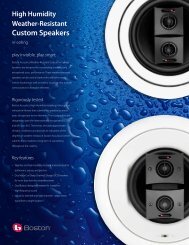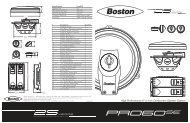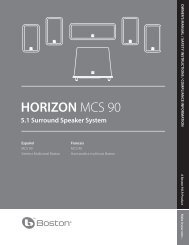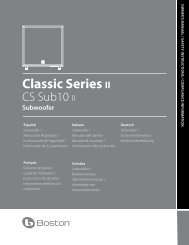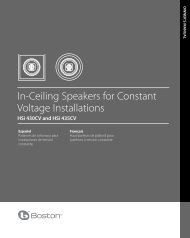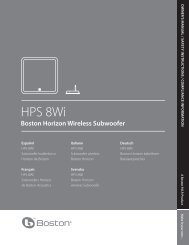SoundWare XL - Boston Acoustics
SoundWare XL - Boston Acoustics
SoundWare XL - Boston Acoustics
You also want an ePaper? Increase the reach of your titles
YUMPU automatically turns print PDFs into web optimized ePapers that Google loves.
<strong>SoundWare</strong> <strong>XL</strong>High Performance Indoor / Outdoor SpeakerFor great sound anywhereEnglishOwner’s Manual / Safety Instructions / Compliance InformationEspañolExcelente sonido en cualquierlugarParlante para interiores/exterioresFrancaisUn son sublime à tout endroitHaut-parleur d’intérieur/extérieurItalianoPer un suono fantasticoovunqueAltoparlante dalle eccellentiprestazioni da interni /all’apertoSvenskaFör toppenljud överalltHögpresterande inomhus/utomhushögtalareDeutschÜberall großartiger SoundHochleistungslautsprecherfür den Einsatz drinnen unddraußen142-003539-0_<strong>SoundWare</strong>_<strong>XL</strong>_Manual.indd 19/9/08 5:56:26 PM
Mounting the Wall BracketBrackets for mounting the speakers on a flat wall or in a corner are supplied. One thing that is notsupplied is hardware to attach the bracket to the wall. Why? Because there are so many different kindsof surfaces on which the speakers could be mounted. It could be basic drywall which may or may nothave a stud behind it. It could be a wood panel or even a concrete foundation wall. There is no onetype of fastener that we could supply that would work in all the possible situations.EnglishTaking into account the surface the speaker is being mounted on, acquire the appropriate type offasteners. You’ll need four for each speaker. If you’re not sure what type of fastener to use, take themounting bracket to a friendly hardware store. Tell them about the surface you’re mounting thespeaker on and the weight of the speaker and ask them to recommend an appropriate fastener.In some communities construction codes may require specific types of mounting hardware andmethods. In addition, some communities require a secondary security support, such as a safety cablebetween the speaker and a structural element of the wall. The <strong>SoundWare</strong> <strong>XL</strong> has a metal bar moldedinto the top of the cabinet to serve as an attachment point for such a secondary support. Consultlocal construction codes to see if there are required mounting methods or secondary supports.<strong>Boston</strong> <strong>Acoustics</strong> will not be held accountable for any damage caused by incorrect installation.Speaker WiresThe type of speaker wire that should be used depends on whether the <strong>SoundWare</strong> <strong>XL</strong> is used in aconventional audio system or in a 100V/70V Constant Voltage commercial system.Conventional Audio SystemsFor short runs of less then 20 feet or so you can use 16 gauge wire. But typically you should useheavier 14 gauge wire. That is good enough for runs up to 50 feet or so. For runs of more than 50 feetuse 12 gauge wire.100V/70V Constant Voltage SystemsThe electrical codes in your community may require the use of special wire that is appropriate forhigher voltage applications and resistant to exposure. Such wire is often called “plenum rated” wire.Check with an electrical safety inspector in your area to see if such wiring is required.One of the main advantages of 100V/70V Constant Voltage systems is that relatively light gauge wirecan be used, even over long distances. In most installations 18 gauge wire will be more than enough.Only in very high power systems is anything heavier needed.142-003539-0_<strong>SoundWare</strong>_<strong>XL</strong>_Manual.indd 39/9/08 5:56:27 PM
EnglishSpeaker Connection PolarityAll the speakers in a system must be hooked up with the same polarity or “in phase.” The terminalson the <strong>SoundWare</strong> <strong>XL</strong> speakers are color coded to identify the “+” (red) and “–” (black) connections.All wire is marked in some way so you can tell one conductor from the other. The marking may be aridge molded into the insulation of one conductor, or it may have a stripe on the insulation, or it maybe color coded. Use the marking on the speaker wires to be sure that the “+” terminal of the amplifieris connected to the “+” terminal of the speaker, and “–” is connected to “–”, at every connection.Connecting the SpeakersBefore connecting the speakers:1 Turn off all the system components.2 Set the transformer switch to the appropriate position. If the speaker is being connected to aconventional audio system, set the switch to the Dir X position. This overrides the transformer andsends the signal directly to the crossover. If the speaker is part of a 100V/70V Constant Voltagesystem, see the information on the following page.Separate the two conductors of the wire. Remove about 3/8”of insulation from the end of the wire. Push down on the topof the terminal to open the hole for the wire. Insert the wireand release the terminal to secure it. Be sure there are no loosestrands of wire. Tuck the wire into the channel in the back of thespeaker to keep it neat and out of sight.21Pivot SetScrewMounting the SpeakersOnce you have the bracket mounted and the speakerconnected the rest is easy.1 Put the rounded end of the speaker mount in thebracket and slide it down to lock it in place.2 Optional – Insert and tighten the screw to secureeverything.The <strong>SoundWare</strong> <strong>XL</strong> can pivot on its mount.Vertically it can go from facing straight out,to being tilted down 40 degrees. When theflat wall mounting bracket is used they canpivot side-to-side 20 degrees. (Note: Cornermounting will not allow the speaker to pivotside-to-side.) Loosen the pivot set screw,pivot the speaker into position and retightenthe screw.pivotsdown 40°pivots 20°each way142-003539-0_<strong>SoundWare</strong>_<strong>XL</strong>_Manual.indd 49/9/08 5:56:29 PM
100V/70V Constant Voltage System UsageThe <strong>SoundWare</strong> <strong>XL</strong> is equipped with a 60 watt transformer for use in 100V/70V Constant Voltageapplications.70 Volt 64W 32W 16W 8W 4W Direct 8 ohms100 Volt – 16W 8W 4W 2W Direct 8 ohmsEnglishAdjust the tap switch on the rear of the speaker to the desired setting so it will be matched to thespeaker wiring coming from the power amplifier. In conventional audio systems, set the tap switch tothe Dir X position. This bypasses the transformer, sending the signal directly to the speaker crossover.In 100V/70V Constant Voltage systems where multiple speakers are used, the speakers must beconnected in parallel. Never use series connections in multi-speaker 100V/70V Constant Voltagesystems.70V25V4 OHMSCOM70V amplifierThis shows the “chain” type parallel speaker connection method. It isthe simplest method and uses the least amount of wire. The “homerun” method, where every speaker wire goes from a speaker directly tothe amplifier, may also be used. However that method uses more wireand can be difficult to connect to the amplfier terminals if more thantwo pairs of speaker are being connected.Note: 100V/70V Constant Voltage systems may be considered high voltage wiring by local buildingcodes. It is the responsibility of the installer to insure that the proper wiring is used when doing theinstallation. Reference: National Electrical Code (NEC) Section 640.9.142-003539-0_<strong>SoundWare</strong>_<strong>XL</strong>_Manual.indd 59/9/08 5:56:30 PM
EnglishLimited Warranty<strong>Boston</strong> <strong>Acoustics</strong> warrants to the original purchaser of our <strong>SoundWare</strong> <strong>XL</strong> loudspeakers that they willbe free of defects in materials and workmanship for a period of 5 years from the date of purchase.Your responsibilities are to install and use them according to the instructions supplied, to provide safeand secure transportation to an authorized <strong>Boston</strong> <strong>Acoustics</strong> service representative, and to presentproof of purchase in the form of your sales slip when requesting service.Excluded from this warranty is damage that results from abuse, misuse, improper installation,accidents, shipping, or repairs/modifications by anyone other than an authorized <strong>Boston</strong> <strong>Acoustics</strong>service representative.This warranty is limited to the <strong>Boston</strong> <strong>Acoustics</strong> product and does not cover damage to anyassociated equipment. This warranty does not cover the cost of removal or reinstallation. Thiswarranty is void if the serial number has been removed or defaced. This warranty gives you specificlegal rights, and you may also have other rights which vary from state to state.If Service Seems NecessaryFirst, contact the dealer from whom you purchased the product. If that is not possible, write to:<strong>Boston</strong> <strong>Acoustics</strong>, Inc.D & M Holdings100 Corporate DriveMahwah, NJ 07430 USAOr contact us via e-mail at:US: support@bostona.comJapan: ba_info@dm-holdings.comAsia Pacific: service@dm-singapore.comWe will promptly advise you of what action to take. If it is necessary to return your <strong>SoundWare</strong> <strong>XL</strong>speaker to the factory, please ship it prepaid. After it has been repaired, we will return it freightprepaid in the United States and Canada.For EU Countries OnlyThis symbol found on the product indicates that the product must not be disposed of withhousehold waste. Instead, it may be placed in a separate collection facility for electronic wasteor returned to a retailer when purchasing similar product. The producer paid to recycle thisproduct. Doing this contributes to reuse and recycling, minimizes adverse effects on theenvironment and human health and avoids any fines for incorrect disposal.142-003539-0_<strong>SoundWare</strong>_<strong>XL</strong>_Manual.indd 69/9/08 5:56:30 PM
Descripción<strong>SoundWare</strong> <strong>XL</strong> de <strong>Boston</strong> <strong>Acoustics</strong>® es verdaderamente un parlante para llevar a cualquier lugar,para lo que necesite. Todas sus partes son impermeables y de ese modo cumplen su cometido eninteriores y exteriores y funcionan en sistemas que incluyen desde entretenimiento al aire libre hastacine en casa.EsPAñOLEl tamaño razonable y el sistema de montaje flexible de <strong>SoundWare</strong> <strong>XL</strong> le brindan muchas opcionesa la hora de elegir el lugar de instalación. Puede simplemente armarlos sobre un estante o usar lossoportes suministrados y montarlos en un rincón o en una pared plana. Los soportes giratorios lepermiten inclinar y bascular los parlantes para adaptarlos a las necesidades de la instalación. Si unode los colores disponibles no se adapta a su decorado, puede pintar <strong>SoundWare</strong> <strong>XL</strong> en un color quecombine o complementario.Además, <strong>SoundWare</strong> <strong>XL</strong> tiene un transformador incorporado que le permite usarlo en sistemas deaudio convencionales o en sistemas de voltaje constante de 100V/70V. Se adaptan muy bien a lasinstalaciones comerciales con múltiples parlantes.EspecificacionesRespuesta de frecuenciaPotencia de amperaje recomendadaImpedancia nominalSensibilidadWooferTweeterFrecuencia de transiciónPeso neto70Hz-25kHz (±3dB)15 – 150 vatios8 ohms86dBcontrol de 6 1 ⁄2” (165mm)cúpula de 1” (25mm)2kHz8,4 lbs (3,9kg)Dimensiones (Alto x ancho x profundidad) 7 7 ⁄8 x 7 7 ⁄8 x 8 9 ⁄16” (201 x 201 x 217mm)Opciones de colocaciónEl parlante <strong>SoundWare</strong> <strong>XL</strong> se puede montar en la pared, con los elementos de ferreteríasuministrados, o simplemente sobre un estante. Si se lo coloca en un estante, simplemente adose elpie de goma con reverso adhesivo yconecte los cables del parlante.Colocación del soporte esférico giratorioSi tiene pensado usar los soportes de montaje debe acoplarel soporte esférico giratorio al parlante. Use los cuatrotornillos mecánicos de cabeza plana que se suministran talcomo se muestra en la ilustración.142-003539-0_<strong>SoundWare</strong>_<strong>XL</strong>_Manual.indd 79/9/08 5:56:31 PM
EsPAñOLMontaje del soporte de paredSe suministran soportes para montar los parlantes en una pared plana o en un rincón. No sesuministran elementos de ferretería para acoplar el soporte a la pared. ¿Por qué? Porque hay muchostipos de superficies diferentes en las cuales pueden instalarse los parlantes. Se puede tratar de unapared de mampostería básica con o sin resalto. Puede ser un panel de madera o hasta una pared conbase de hormigón. No existe un único tipo de sujetador que podríamos suministrar y que funcionaríaen todas las situaciones posibles.Tenga en cuenta la superficie en la que se instalará el parlante para adquirir el tipo apropiado desujetadores. Necesitará cuatro para cada parlante. Si no está seguro de qué tipo de sujetador debeusar, lleve el soporte de montaje a una ferretería conocida. Dígales el tipo de superficie sobre la cualva a instalar el parlante y el peso del parlante para que ellos le recomienden el sujetador apropiado.En algunas comunidades los códigos de edificación pueden exigir el uso de tipos de elementos deferretería y métodos de instalación específicos. Además, tal vez le exijan un soporte de seguridadsecundario, por ejemplo, un cable de seguridad entre el parlante y el elemento estructural de lapared. <strong>SoundWare</strong> <strong>XL</strong> tiene una barra de metal moldeada en la parte superior del gabinete, la cualsirve como punto de sujeción para tal soporte secundario. Consulte los códigos de edificación localespara ver si es necesario aplicar métodos de instalación o soportes secundarios.<strong>Boston</strong> <strong>Acoustics</strong> no asume responsabilidad alguna por los daños que puedan resultar de una instalaciónincorrecta.Cables de los parlantesEl tipo de cable de parlante que se debe utilizar depende de que <strong>SoundWare</strong> <strong>XL</strong> se use en un sistemade audio convencional o en un sistema comercial de voltaje constante de 100V/70V.Sistemas de audio convencionalesPara tramos cortos de menos de 20 pies o distancias similares se puede usar cable de calibre 16.Típicamente se debe usar cable de calibre superior a 14. Esa medida es correcta para recorridos dehasta unos 50 pies. Para recorridos de más de 50 pies se debe usar cable de calibre 12.Sistemas de voltaje constante de 100V/70VLos códigos eléctricos de su comunidad pueden exigir el uso de cable especial que sea apropiadopara aplicaciones de mayor voltaje y que resistan la exposición. Tal cable a menudo se denomina"cable con clasificación plenum". Consulte con un inspector de seguridad eléctrica de su área parasaber si es necesario usar ese tipo de cable.Una de las principales ventajas de los sistemas de voltaje constante de 100V/70V es que se puedeusar cable de calibre relativamente ligero, aún en distancias más largas. En la mayoría de lasinstalaciones será más que suficiente usar cable de calibre 18. Solamente se necesita cable de mayorcalibre en sistemas de muy alta potencia.142-003539-0_<strong>SoundWare</strong>_<strong>XL</strong>_Manual.indd 89/9/08 5:56:31 PM
Polaridad de conexión de los parlantesTodos los parlantes de un sistema se deben conectar con la misma polaridad o "en fase". Losterminales de los parlantes <strong>SoundWare</strong> <strong>XL</strong> están codificados por color para identificar las conexiones“+” (rojo) y “–” (negro). Todos los cables vienen marcados de alguna forma y de esa manera se puededistinguir entre un conductor y otro. La marcación puede consistir en una estría en la aislación deun conductor o puede ser una raya sobre la aislación o codificación por color. Use las marcas de loscables de los parlantes para estar seguro de que el terminal "+" del amplificador esté conectado alterminal "+" del parlante y que "-" esté conectado a "-", en cada conexión.EsPAñOLConexión de los parlantesAntes de conectar los parlantes:1 Apague todos los componentes del sistema.2 Coloque el interruptor del transformador en la posición apropiada. Si el parlante se estáconectando a un sistema de audio convencional, coloque el interruptor en la posición Dir X. Estocancela el efecto del transformador y envía la señal directamente a la transición. Si el parlantees parte de un sistema de voltaje constante de 100V/70V, consulte la información de la páginasiguiente.Separe los dos conductores del cable. Desprendaaproximadamente 3/8” de la aislación del extremo del cable.Empuje hacia abajo sobre el extremo superior del terminal paraabrir el orificio para el cable. Inserte el cable y suelte el terminalpara ajustarlo. Asegúrese de que no queden filamentos de cablesueltos. Meta el cable dentro del canal en la parte posterior delparlante para una terminación prolija, que no se vea.21Tornillo de Pivot fijación Setde rotación ScrewInstalación de los parlantesUna vez que haya instalado el soporte y conectado elparlante, el resto es fácil.1 Coloque el extremo redondeado del soporte delparlante en el soporte y deslícelo hacia abajo paraque quede fijo en su lugar.2 Opcional - Inserte y ajuste el tornillo para fijar todo.<strong>SoundWare</strong> <strong>XL</strong> puede girar sobre el soporte.En sentido vertical puede moverse desdeuna posición recta hacia afuera hasta unainclinación hacia abajo de 40 grados. Cuandose usa el soporte de montaje en pared planael parlante puede rotar lado a lado 20 grados.(Nota: Si se instala en un rincón el parlante nopodrá rotar lado a lado.) Afloje el tornillo defijación de rotación, gire el parlante a su lugary vuelva a ajustar el tornillo.gira 40ºpivotshacia down abajo 40°gira 20º apivots 20°cadaeachladoway142-003539-0_<strong>SoundWare</strong>_<strong>XL</strong>_Manual.indd 99/9/08 5:56:32 PM
EsPAñOLUso de sistemas de voltaje constante de 100V/70V<strong>SoundWare</strong> <strong>XL</strong> viene equipado con un transformador de 60 vatios para aplicaciones con voltajeconstante de 100V/70V.70 Volt 64W 32W 16W 8W 4W 8 ohms direct.100 Volt – 16W 8W 4W 2W 8 ohms direct.Ajuste el conmutador de derivación que se encuentra en la parte posterior del parlante al valordeseado de manera que combine con el cableado del parlante que viene del amplificador depotencia. En los sistemas de audio convencionales, coloque el conmutador de derivación en laposición Dir X. Esto evita el transformador y envía la señal directamente a la transición del parlante.En los sistemas de voltaje de 100V/70V en los cuales se usan múltiples parlantes, los parlantes sedeben conectar en paralelo. Nunca use conexiones en serie en sistemas de voltaje constante de100V/70V con múltiples parlantes.70V25V4 OHMSCOM70V amplifierAmplificador 70VEsto muestra el método de conexión de parlantes paralelos tipo "cadena".Es el método más simple y utiliza la menor cantidad de cable. También sepuede usar el método "home run", en el cual el cable de cada parlante vadirectamente de un parlante directamente al amplificador. Sin embargo,ese método usa más cable y puede ser difícil de conectar a los terminales delamplificador si se están conectando más de dos pares de parlantes.Nota: Los códigos de edificación locales pueden considerar que los sistemas de voltaje constante de100V/70V constituyen cableado de alto voltaje. El instalador es responsable de asegurar que se usecableado apropiado al hacer la instalación. Referencia: Código Eléctrico Nacional (NEC) Sección 640.9.142-003539-0_<strong>SoundWare</strong>_<strong>XL</strong>_Manual.indd 109/9/08 5:56:33 PM
Garantía Limitada<strong>Boston</strong> <strong>Acoustics</strong> garantiza al comprador original que nuestros altoparlantes <strong>SoundWare</strong> <strong>XL</strong> notendrán defectos de materiales ni de mano de obra durante un período de 5 años desde la fecha decompra.EsPAñOLEs responsabilidad suya instalarlos y utilizarlos de acuerdo con las instrucciones suministradas,proporcionar un transporte seguro hasta un representante de servicio autorizado de <strong>Boston</strong><strong>Acoustics</strong>, y presentar la prueba de compra en forma de recibo de compra cuando sea necesario esteservicio.Esta garantía excluye cualquier daño resultante de uso incorrecto, mal uso, instalación inadecuada,accidentes, transporte o reparaciones/modificaciones que no sean realizadas por un representanteautorizado de servicio de <strong>Boston</strong> <strong>Acoustics</strong>.Esta garantía se limita al producto de <strong>Boston</strong> <strong>Acoustics</strong> y no cubre daños de equiposafines. Esta garantía no cubre los costos de desinstalación o reinstalación. Estagarantía será nula cuando se haya retirado o borrado el número de serie. Esta garantía le otorgaderechos legales específicos y también le podrían corresponder otros derechos que varían de unestado a otro.Si cree que necesita servicio técnicoPrimero, póngase en contacto con el distribuidor al cual ha comprado el producto. Si esto no esposible, escriba a:<strong>Boston</strong> <strong>Acoustics</strong>, Inc.D & M Holdings100 Corporate DriveMahwah, NJ 07430 EE.UU.O póngase en contacto con nosotros por correo electrónico a:En EE.UU.: support@bostona.comEn Japón: ba_info@dm-holdings.comEn Asia Pacífico: service@dm-singapore.comLe indicaremos de inmediato qué acción tomar. Si es necesario devolver su parlante <strong>SoundWare</strong> <strong>XL</strong>a la fábrica, por favor, envíelo con gastos de transporte pagados por anticipado. Después de lareparación, se lo devolveremos con flete pagado por anticipado dentro de los Estados Unidos y Canadá.Sólo para países de la UEEste símbolo que aparece en el producto indica que el producto no debe ser eliminado juntocon los residuos domésticos. Debe colocarse en un punto de recolección separada paradesechos electrónicos o devuelto a un establecimiento minorista al comprar un productosimilar. El fabricante ha pagado para que este producto se recicle. Esta práctica contribuye ala reutilización y el reciclado, minimiza los efectos adversos sobre el medio ambiente y la saludhumana y evita la imposición de multas por eliminación incorrecta de residuos.142-003539-0_<strong>SoundWare</strong>_<strong>XL</strong>_Manual.indd 119/9/08 5:56:33 PM
FRANçAISDescriptionLe <strong>Boston</strong> <strong>Acoustics</strong>® <strong>SoundWare</strong> <strong>XL</strong> est véritablement un haut-parleur flexible. Tous les composantsrésistent aux intempéries, permettant une installation aussi bien en extérieur pour les loisirs qu’enintérieur pour le home-cinéma.La taille raisonnable et le système de fixation flexible du <strong>SoundWare</strong> <strong>XL</strong> vous offrent de nombreusesoptions d'installation. Vous pouvez poser le haut-parleur sur une étagère ou employer les supportsfournis pour l'installer dans un coin ou le fixer à un mur. Les supports pivotants vous permettentd’incliner et de tourner le haut-parleur en fonction de votre installation. Si aucune des couleursproposées ne correspond à votre décoration, vous pouvez peindre le <strong>SoundWare</strong> <strong>XL</strong> dans unecouleur appariée.En outre, le <strong>SoundWare</strong> <strong>XL</strong> dispose d'un transformateur intégré qui permet de l'utiliser dansdes systèmes audio conventionnels ou des systèmes à tension constante 100V/70V. Il est doncparfaitement adapté aux installations commerciales à haut-parleurs multiples.SpécificationsDistorsion de fréquence :Puissance d'amplificateur recommandéeImpédance nominale :SensibilitéHaut-parleur de gravesHaut-parleur d'aigusFréquence de coupurePoids netDimensions (H x L x P)70Hz-25kHz (±3dB)15 – 150 watts8 ohms86dBAmplificateur de 6 1 ⁄2” (165mm)Dôme de 1” (25mm)2kHz8.4 lbs (3,9kg)7 7 ⁄8 x 7 7 ⁄8 x 8 9 ⁄16” (201 x 201 x 217mm)Options de positionnementLe haut-parleur <strong>SoundWare</strong> <strong>XL</strong> peut être fixé sur un mur à l’aide du matériel fourni ou simplementposé sur une étagère. S’il est placé sur une étagère, fixez simplement le pied adhésif en caoutchouc etbranchez les fils.Fixation du support à rotule pivotanteSi vous désirez utiliser les supports de montage, vous devezfixer le support à rotule pivotante au haut-parleur. Utilisezles quatre vis de mécanique à tête fraisée fournies, commeillustré.142-003539-0_<strong>SoundWare</strong>_<strong>XL</strong>_Manual.indd 129/9/08 5:56:34 PM
Fixation du support muralLes supports de fixation des haut-parleurs sur un mur plat ou dans un coin sont fournis. Toutefois, lematériel de fixation au mur n’est pas fourni. Pourquoi ? Car les haut-parleurs peuvent être fixés sur denombreuses surfaces différentes. Il peut s’agir d’une cloison sèche ordinaire qui peut être supportéeou non par un poteau. Il peut s’agir d’un panneau en bois ou même d’un mur de fondation en béton.Nous ne pouvons fournir aucune pièce de fixation unique, adaptée à toutes les situations.FRANçAISEn prenant en compte la surface sur laquelle vous fixez le haut-parleur, veuillez acheter les pièces defixation adaptées. Vous avez besoin de quatre pièces de fixation par haut-parleur. Si vous ne savez pasquel type de fixation utiliser, apportez le support de fixation dans un magasin de bricolage. Indiquezle type de surface sur lequel le haut-parleur sera fixé et le poids du haut-parleur. Demandez la fixationrecommandée.Dans certaines communautés, les codes relatifs à la construction peuvent nécessiter un matériel etdes méthodes de fixation spécifiques. En outre, certaines communautés exigent l'utilisation d'unsupport de sécurité secondaire, tel qu'un câble de sécurité installé entre le haut-parleur et un élémentstructurel du mur. Le <strong>SoundWare</strong> <strong>XL</strong> est pourvu d'une moulure métallique au sommet de l'enceintequi sert de point de fixation pour un tel support secondaire. Consultez les codes de constructionlocaux pour connaître les méthodes de fixation ou les supports secondaires requis.<strong>Boston</strong> <strong>Acoustics</strong> ne pourra pas être tenu pour responsable de tout dommage découlant d'une installationincorrecte.Fils des haut-parleursLe type de fil à utiliser dépend de l'utilisation du <strong>SoundWare</strong> <strong>XL</strong> dans un système audio conventionnelou un système commercial à tension constante 100V/70V.Systèmes audio conventionnelsPour les distances de moins de 6m, vous pouvez utiliser un fil de calibre 16. Mais, en général, vousdevez utiliser un fil d'un calibre supérieur à 14. Ce type de fil convient aux distances allant jusqu’à15m. Pour des chemins supérieurs à 15m, utilisez un fil de calibre 12.Systèmes à tension constante 100V/70VLes codes d'électricité de votre communauté peuvent requérir l'utilisation d'un fil spécial qui convientaux applications à haute tension et qui résiste aux intempéries. Ce fil est souvent dénommé « filignifugé ». Vérifiez avec un inspecteur de la sécurité électrique de votre région pour savoir si un tel filest nécessaire.L'un des principaux avantages des systèmes à tension constante 100V/70V est l'utilisation de fils defaible calibre, même sur de longues distances. Dans la plupart des installations, des fils de calibre 18peuvent être utilisés. Un fil d'un calibre supérieur doit être utilisé uniquement dans un système à trèshaute puissance.142-003539-0_<strong>SoundWare</strong>_<strong>XL</strong>_Manual.indd 139/9/08 5:56:34 PM
FRANçAISPolarité de branchement des haut-parleursTous les haut-parleurs d’un système doivent être réglés sur la même polarité, c’est-à-dire qu'ils doiventêtre « en phase ». Les bornes des haut-parleurs <strong>SoundWare</strong> <strong>XL</strong> sont codées par couleur pour identifierles bornes « + » (rouge) et « - » (noire). Tous les fils sont marqués d’une manière ou d’une autre afinde pouvoir distinguer les conducteurs. Le marquage peut être moulé dans la gaine d’un conducteur,ou la gaine peut être striée, ou il peut s’agir d’un code couleur. Pour chaque connexion, utilisez lemarquage des fils des haut-parleurs pour vérifier que la borne « + » de l’amplificateur est branchée àla borne « + » du haut-parleur, et que la borne « - » est branchée à la borne « - ».Branchement des haut-parleursAvant de brancher les haut-parleurs :1 Éteignez tous les composants du système.2 Placez l'interrupteur du transformateur en position appropriée. Si le haut-parleur est branché àun système audio conventionnel, réglez l'interrupteur sur la position Dir X. Ce réglage ignore letransformateur et envoie le signal directement au répartiteur. Si le haut-parleur fait partie d'unsystème à tension constante 100V/70V, consultez les informations de la page suivante.Séparez les deux conducteurs du fil. À l’extrémité du fil,dénudez la gaine sur environ 9,50 mm. Appuyez sur le sommetde la borne pour ouvrir un orifice destiné au fil. Insérez le filet relâchez la borne pour bloquer le fil. Vérifiez que tous lesconducteurs de fil sont insérés. Rentrez le fil dans le canal àl'arrière du haut-parleur pour qu'il soit rangé et invisible.21Vis de pression Pivot Setdu pivotScrewLe <strong>SoundWare</strong> <strong>XL</strong> peut pivoter sur sonsupport. Il peut être incliné de 40 degrés versle bas dans le sens vertical. Quand le supportde fixation mural est employé, le haut-parleurpeut pivoter latéralement de 20 degrés.(Note : le support de coin ne permet pasde faire pivoter le haut-parleur dans le senslatéral.) Desserrez la vis de fixation du pivot,faites pivoter le haut-parleur en position etresserrez la vis.Fixation des haut-parleursDès que le support est monté et le haut-parleur branché,la procédure suivante est simple.1 Placez l’extrémité arrondie du support du haut-parleurdans le support mural et faites-le glisser pour lebloquer en place.2 En option – Insérez et serrez la vis pour sécuriserl’ensemble.pivote de 40°vers pivots le basdown 40°pivote de 20° danschaque pivots 20° senseach way142-003539-0_<strong>SoundWare</strong>_<strong>XL</strong>_Manual.indd 149/9/08 5:56:36 PM
Utilisation d'un système à tension constante 100V/70VLe <strong>SoundWare</strong> <strong>XL</strong> est équipé d'un transformateur de 60 watts pour une utilisation dans lesapplications à tension constante 100V/70V.70 volts 64W 32W 16W 8W 4W Direct 8 ohms100 volts – 16W 8W 4W 2W Direct 8 ohmsFRANçAISAjustez le commutateur à prises situé à l'arrière du haut-parleur en le plaçant dans la positionsouhaitée qui correspondra au câblage du haut-parleur provenant de l'amplificateur de puissance.Dans des systèmes audio conventionnels, réglez le commutateur à prises en position Dir X. Ce réglageignore le transformateur en envoyant le signal directement au répartiteur du haut-parleur.Dans les systèmes à tension constante 100V/70V où de multiples haut-parleurs sont employés, leshaut-parleurs doivent être branchés en parallèle. N'utilisez jamais des branchements en série dansun système à tension constante 100V/70V à haut-parleurs multiples.70V25V4 OHMSCOM70V amplifierAmplificateur de 70VCe schéma illustre la méthode de branchement en parallèle de type« chaîne » des haut-parleurs. Il s'agit de la méthode la plus simple quiconsomme le moins de câble. La méthode « individuelle », dans laquellechaque fil de haut-parleur entre directement dans l'amplificateur, peutégalement être utilisée. Toutefois, cette méthode nécessite davantagede câble et le branchement aux bornes de l'amplificateur peut s'avérerdifficile si le système comprend plus de deux paires de haut-parleurs.Note : les systèmes à tension constante 100V/70V peuvent être considérés par les codes deconstruction locaux comme des câblages à haute tension. L'installateur est responsable de s'assurerpendant l'installation que le câblage utilisé est correct. Référence : Section 640.9 du Code national del'électricité (NEC) des États-Unis142-003539-0_<strong>SoundWare</strong>_<strong>XL</strong>_Manual.indd 159/9/08 5:56:36 PM
FRANçAISGarantie limitée<strong>Boston</strong> <strong>Acoustics</strong> garantit à l’acheteur d’origine que les enceintes <strong>SoundWare</strong> <strong>XL</strong> ne comportentaucun défaut de pièce et main d’œuvre pendant une période de 5 ans à partir de la date d’achat.Votre responsabilité consiste à installer et à utiliser les haut-parleurs en accord avec les instructionsfournies, à assurer un transport sécurisé vers un représentant de service agréé de <strong>Boston</strong> <strong>Acoustics</strong>,et à présenter une preuve d’achat sous la forme d’un ticket de caisse en cas de demande de serviceaprès-vente.Les dommages résultant d’une utilisation abusive ou erronée, d’une installation incorrecte,d’un accident, d’une expédition inadaptée, ou de réparations / modifications par une personne autrequ’un représentant de service agréé de <strong>Boston</strong> <strong>Acoustics</strong> sont exclus de cette garantie.La présente garantie est réservée au produit de <strong>Boston</strong> <strong>Acoustics</strong> et ne couvre pas les dommagesd’un quelconque équipement associé. Elle ne couvre pas le coût de l’enlèvement ou de laréinstallation. Laprésente garantie est annulée si le numéro de série a été enlevé ou abîmé. Cette garantie vousaccorde des droits légaux spécifiques. Vous pouvez disposer de droits complémentaires qui diffèrentd’un état à l’autre.Demande de service après-venteVeuillez contacter en premier lieu le revendeur auprès duquel vous avez acheté ce produit. Si aucuneassistance n’est possible, veuillez écrire à :<strong>Boston</strong> <strong>Acoustics</strong>, Inc.D & M Holdings100 Corporate DriveMahwah, NJ 07430 États-UnisOu veuillez nous contacter par e-mail :États-Unis :support@bostona.comJapon :ba_info@dm-holdings.comAsie du Pacifique : service@dm-singapore.comNous vous informerons rapidement des mesures à prendre. Si vous devez retourner votre hautparleur<strong>SoundWare</strong> <strong>XL</strong> à l’usine, veuillez l’expédier en colis prépayé. Après la réparation, il vous seraretourné en fret prépayé aux États-Unis et au Canada.Pour les pays de l’UE uniquementLa présence de ce symbole sur le produit indique que ce dernier ne peut pas être jeté dansles ordures ménagères. Vous devez le déposer dans une installation de collecte séparée,destinée aux déchets électroniques, ou le retourner chez un revendeur lors de l’achat d’unproduit similaire. Le fabricant a payé pour le recyclage de ce produit. Ainsi, vous contribuezà la réutilisation et au recyclage ; vous minimisez les effets néfastes sur l’environnement et lasanté ; et vous évitez des amendes pour une mise au rebut incorrecte.142-003539-0_<strong>SoundWare</strong>_<strong>XL</strong>_Manual.indd 169/9/08 5:56:37 PM
DescrizioneIl <strong>Boston</strong> <strong>Acoustics</strong>® <strong>SoundWare</strong> <strong>XL</strong> è realmente un altoparlante che ti segue dappertutto e che fa ditutto. Tutte le parti che lo compongono sono impermeabili, quindi è perfettamente a suo agio siaall'interno che all'aperto ed è adatto sia alle esibizioni all'aperto che ai sistemi di home theater.Le dimensioni ragionevoli e il sistema di montaggio flessibile del <strong>SoundWare</strong> <strong>XL</strong> vi offre numeroseopzioni per quanto riguarda i luoghi in cui installarlo. È possibile collocarlo su uno scaffale o servirsidelle staffe in dotazione per montarlo in un angolo o su una parete liscia. I dispositivi di montaggiogirevoli consentono di inclinare e di orientare le casse per meglio adattarle all'installazione. Senessuno dei colori disponibili si intona al vostro arredamento, il <strong>SoundWare</strong> <strong>XL</strong> può essere dipinto conun colore in tinta o complementare.ITALIANOInoltre, il <strong>SoundWare</strong> <strong>XL</strong> è dotato di un trasformatore incorporato che ne consente l'uso in sistemiaudio convenzionali o in impianti a tensione costante 100V/70V. È dunque adatto a impianticommerciali multi-altoparlante.SpecificheRisposta di frequenzaPotenza ampli raccomandataImpedenza nominaleSensibilitàWooferTweeterFrequenza di crossoverPeso nettoDimensioni (H x L x P)70Hz-25kHz (±3dB)15 – 150 watt8 ohm86dB6 1 ⁄2” (165mm) Driver1” (25mm) duomo2kHz3,9 kg (8,4 lb)7 7 ⁄8 x 7 7 ⁄8 x 8 9 ⁄16” (201 x 201 x 217mm)Opzioni di collocazioneL'altoparlante <strong>SoundWare</strong> <strong>XL</strong> può essere installato a parete servendosi degli accessori in dotazioneoppure semplicemente collocato su uno scaffale. Se viene collocato su uno scaffale, si possonofissare i piedini in gomma dotati di adesivo e collegare i fili dell'altoparlante.Fissare il dispositivo di montaggio girevole a sferaSe si intende utilizzare le staffe di montaggio, occorre fissareil dispositivo di montaggio girevole a sfera all'altoparlante.Servirsi delle quattro viti piatte in dotazione come illustrato.142-003539-0_<strong>SoundWare</strong>_<strong>XL</strong>_Manual.indd 179/9/08 5:56:37 PM
ITALIANOMontaggio delle staffe a pareteSono fornite staffe per l'installazione degli altoparlanti su una parete liscia o in un angolo. CIò chenon è in dotazione sono gli accessori per fissare la staffa alla parete. Perché? Vi sono moltissimi tipi disuperfici alle quali è possibile installare gli altoparlanti. Potrebbe trattarsi di semplice cartongesso chepotrebbe nascondere o meno una trave. Potrebbe essere un pannello di legno o perfino un muroportante in cemento. Non vi è quindi un unico tipo di dispositivo di bloccaggio che potessimo forniree che fosse in grado di adattarsi ad ogni situazione possibile.Sarà quindi necessario procurarsi quelli più adeguati, tenendo conto del tipo di superficie sulla qualesi sta installando l'altoparlante. Ne occorrono quattro per ogni altoparlante. In caso di dubbio circail tipo di tassello da utilizzare, portare la staffa di montaggio da un ferramenta di fiducia. Descrivereil tipo di superficie sulla quale si sta installando l'altoparlante, specificandone il peso, e chiedere diindicare il tassello adeguato.In alcune aree i codici edilizi possono richiedere tipi specifici di dispositivi e di tecniche di montaggio.Inoltre, alcuni comuni richiedono un supporto di sicurezza secondario, quale un cavo di sicurezzaposto tra l'altoparlante e l'elemento strutturale del muro. Il <strong>SoundWare</strong> <strong>XL</strong> presenta una barrametallica fusa a livello della parte superiore del corpo che può essere utilizzata come punto difissaggio per tale supporto secondario. Consultare i codici edilizi locali per verificare se richiedonospecifici metodi di installazione o l'uso di supporti secondari.<strong>Boston</strong> <strong>Acoustics</strong> non sarà responsabile di eventuali danni causati da un'installazione scorretta.Fili dell'altoparlanteIl tipo di cavo da utilizzarsi con l'altoparlante dipende dall'uso che se ne fa: se viene utilizzato in unimpianto audio convenzionale o in un impianto commerciale a voltaggio costante 100V/70V.Impianti audio convenzionaliPer brevi distanze di meno di 6 metri circa si può utilizzare un cavo di calibro 16. Ma solitamente sidovrebbe utilizzar eun cavo più pesante, di calibro 14. Questo è sufficiente per distanze di circa 15metri. Per distanze superiori a 15 metri, servirsi di cavo di calibro 12.Impianti a voltaggio costante 100V/70VIl codice elettrico della vostra zona potrebbe richiedere l'uso di filo speciale adeguato adapparecchiature a voltaggio più elevato e resistenti all'esposizione. Questo tipo di cavo è spessodenominato “plenum”. Verificare con un ispettore specializzato in sicurezza elettrica se tale cablaggioè necessario.Uno dei principali vantaggi degli impianti a voltaggio costante 100V/70V è che può essere utilizzatoun cavo dal calibro relativamente leggero, anche per lunghe distanze. Nella maggior parte degliimpianti un cavo di calibro 18 sarà più che sufficiente. Solo in impianti dalla elevata alimentazionesono necessari cavi più pesanti.142-003539-0_<strong>SoundWare</strong>_<strong>XL</strong>_Manual.indd 189/9/08 5:56:38 PM
Polarità di connessione degli altoparlantiTutti gli altoparlanti compresi nel sistema devono essere collegati secondo la stessa polarità o “in fase”.I terminali degli altoparlanti <strong>SoundWare</strong> <strong>XL</strong> sono differenziati secondo un codice cromatico che servea identificare i connettori “+” (rossi) e “–” (neri). Tutti i fili sono contrassegnati in un modo o nell'altro,quindi è possibile distinguere un conduttore dall'altro. La marcatura può essere un rilievo saldatonell'isolamento di un conduttore oppure una striscia a livello dell'isolamento, oppure ancora puòseguire un codice cromatico. Servirsi della marcatura a livello dei fili dell'altoparlante per assicurarsiche il terminale “+” dell'amplificatore sia collegato al terminale “+” dell'altoparlante e che “–” siacollegato a “–”, a livello di tutti i collegamenti.ITALIANOCollegare gli altoparlantiPrima di collegare gli altoparlanti:1 Spegnere tutti i componenti del sistema.2 Impostare adeguatamente l'interruttore del trasformatore. Se l'altoparlante viene collegatoad un sistema audio convenzionale, impostare l'interruttore su Dir X. Così facendo si aggira iltrasformatore e si invia il segnale direttamente al crossover. Se l'altoparlante è parte di un impiantoa voltaggio costante 100V/70V, si vedano le informazioni in merito nella prossima pagina.Separare i due conduttori del cavo. Rimuovere circa 10 mmdell'isolamento del filo. Schiacciare il terminale per aprire ilforo per il filo. Inserire il filo e rilasciare il terminale per fissarlo.Assicurarsi che non vi siano fasci liberi di filo. Rincalzare il filo nelcanale nel retro dell'altoparlante per mantenerlo ordinato e fuorivista.21Vite Pivot per set Setgirevole ScrewInstallazione degli altoparlantiUna volta montata la staffa e collegato l'altoparlante, ilresto è facile.1 Collocare il capo arrotondato del dispositivo dimontaggio dell'altoparlante nella staffa e farloscorrere verso il basso per bloccarlo in posizione.2 Opzionale – Inserire e stringere la vite per fissare iltutto.Il <strong>SoundWare</strong> <strong>XL</strong> può ruotare sul suosupporto. Verticalmente, può passaredall'essere frontale a essere inclinato di 40gradi. Quando la staffa piatta di installazionea muro viene utilizzata, sono in grado diruotare da un lato all'altro di 20 gradi. (Notabene: L'installazione angolare non permetteràall'altoparlante di ruotare da un lato all'altro.)Allentare la vite per la rotazione, far ruotarel'altoparlante in posizione e stringere nuovamente la vite.ruota verso ilbasso pivots di 40°down 40°ruota di 20° inogni pivots senso 20°each way142-003539-0_<strong>SoundWare</strong>_<strong>XL</strong>_Manual.indd 199/9/08 5:56:39 PM
ITALIANOImpiego di impianti a voltaggio costante 100V/70VIl <strong>SoundWare</strong> <strong>XL</strong> è dotato di un trasformatore da 60 watt per l'uso con applicazioni a voltaggiocostante 100V/70V.70 Volt 64W 32W 16W 8W 4W Diretto 8 ohm100 Volt – 16W 8W 4W 2W Diretto 8 ohmRegolare l'interruttore posto sul retro dell'altoparlante come desiderato, in modo che corrisponda alcablaggio dell'altoparlante proveniente dall'amplificatore. In sistemi audio convenzionali, impostarel'interruttore su Dir X. Così facendo si aggira il trasformatore e si invia il segnale direttamente alcrossover.In sistemi a voltaggio costante 100V/70V in cui vengono utilizzati più altoparlanti, questi devonoessere collegati in parallelo. Mai servirsi di collegamenti in serie in impianti multi-altoparlante avoltaggio costante 100V/70V.70V25V4 OHMSCOM70V amplifierAmplificatore 70VQuesto mostra il metodo “a catena” di collegamento in parallelodegli altoparlanti. Si tratta del metodo più semplice nonché quelloche impiega la quantità minore di cavo. Può anche essere utilizzato ilmetodo “home run”, in cui ogni filo degli altoparlanti va direttamente daun altoparlante ad un amplificatore. Tuttavia, quel metodo impiega piùcavo e potrebbe risultare difficile collegare i terminali dell'amplificatorese si collegano più di due paia di altoparlanti.Nota bene: I codici edili locali potrebbero considerare i sistemi a voltaggio costante cablaggio ad altatensione. È responsabilità dell'installatore assicurarsi di utilizzare il cablaggio adeguato al momento dieffettuare l'installazione. Riferimento: National Electrical Code (NEC) Sezione 640.9.142-003539-0_<strong>SoundWare</strong>_<strong>XL</strong>_Manual.indd 209/9/08 5:56:40 PM
Garanzia limitata<strong>Boston</strong> <strong>Acoustics</strong> garantisce all’acquirente originale degli altoparlanti serie <strong>SoundWare</strong> <strong>XL</strong> chequesti non presentano alcun difetto nei materiali e nella fattura per un periodo di 5 anni dalla datadell’acquisto.In fase di richiesta di assistenza, è di responsabilità dell’acquirente l’installazione e l’impiego deldispositivo in conformità con le istruzioni fornite, al fine di fornire un trasporto sicuro e protettopresso un rappresentante di assistenza autorizzato <strong>Boston</strong> <strong>Acoustics</strong>, nonché di presentare eventualiprove d’acquisto sotto forma di documento di vendita.ITALIANOLa presente garanzia non include danni derivanti da abuso, cattivo uso, installazione non correttaincidenti, spedizione o riparazioni/modifiche effettuate da personale non autorizzato da <strong>Boston</strong><strong>Acoustics</strong>.Questa garanzia è limitata al prodotto <strong>Boston</strong> <strong>Acoustics</strong> e non copre i danni di alcundispositivo associato. Questa garanzia non copre i costi di rimozione o reinstallazione. Questagaranzia non è valida in mancanza del numero di serie del dispositivo. Questa garanzia fornisceall’utente diritti legali specifici e gli consente di fruire di altri diritti che variano da uno stato all’altro.In caso di necessità di assistenzaContattare innanzitutto il rivenditore presso il quale è stato acquistato il prodotto. Qualora ciò nonfosse possibile, scrivere a:<strong>Boston</strong> <strong>Acoustics</strong>, Inc.D & M Holdings100 Corporate DriveMahwah, NJ 07430 USAO contattateci tramite e-mail all’indirizzo:STATI UNITI: support@bostona.comGiappone: ba_info@dm-holdings.comAsia Pacifico: service@dm-singapore.comVi informeremo immediatamente su come procedere. Se è necessario restituire l'altoparlante<strong>SoundWare</strong> <strong>XL</strong> alla fabbrica, effettuare una spedizione prepagata. In seguito alla riparazione, ve lorestituiremo franco spedizione negli Stati Uniti e Canada.Clienti UEQuesto simbolo riportato sul prodotto indica che il prodotto non può essere smaltito coni rifiuti domestici. Al contrario, esso deve essere smaltito tramite un sistema di smaltimentoapposito per i rifiuti elettronici o restituito al rivenditore all’acquisto di un prodotto simile.Il produttore ha pagato per il riciclaggio di questo prodotto. In tal modo, è possibilecontribuire al reimpiego e riciclaggio dei materiali, si riducono al minimo gli effetti indesideratisull’ambiente e la salute umana e si evitano multe per uno smaltimento errato.142-003539-0_<strong>SoundWare</strong>_<strong>XL</strong>_Manual.indd 219/9/08 5:56:40 PM
DEUTSCHBeschreibungDer <strong>Boston</strong> <strong>Acoustics</strong>® <strong>SoundWare</strong> <strong>XL</strong> ist tatsächlich ein Allround-Lautsprecher, der überall eingesetztwerden kann und alles leistet. Alle seine Teile sind wetterbeständig und fühlen sich demnach drinnenund draußen, bei Entertainment im Freien sowie im Heimkinosystem wie zuhause.Die praktische Größe und das flexible Befestigungssystem des <strong>SoundWare</strong> <strong>XL</strong> ermöglichen esIhnen, ihn an unterschiedlichsten Orten einzusetzen. Sie können Ihn in ein Regal stellen oderdie mitgelieferten Halterungen verwenden, um ihn in eine Ecke oder an eine flache Wand zuhängen. Die schwenkbaren Wandhalterungen ermöglichen es Ihnen, die Lautsprecher je nachEinsatzort zu neigen und zu drehen. Wenn Sie unter den vorgegebenen Farben keine finden, diezu ihrer Einrichtung passt, kann der <strong>SoundWare</strong> <strong>XL</strong> auch ganz einfach in einer passenden oderkomplementären Farbe angestrichen werden.Darüber hinaus verfügt der <strong>SoundWare</strong> <strong>XL</strong> über einen eingebauten Transformator, mithilfe dessendie Lautsprecher in einem herkömmlichen Audiosystem oder einem System mit einer konstantenSpannung von 100V/70V eingesetzt werden können. Sie eignen sich daher also sehr gut für denkommerziellen Einsatz in Multi-Speaker-Systemen.SpezifikationenFrequenzbereich70 Hz - 25 kHz (±3 dB)Empfohlene Verstärkerleistung 15 – 150 WattNominalimpedanzEmpfindlichkeitWooferHochtonTrennfrequenzGewichtAbmessungen (H x B x T)8 Ohm86 dB6 1 ⁄2” (165 mm) Treiber1” (25 mm) Kalotte2 kHz8,4 lbs (3,9 kg)7 7 ⁄8 x 7 7 ⁄8 x 8 9 ⁄16” (201 x 201 x 217 mm)AufstellungsoptionenDer <strong>SoundWare</strong> <strong>XL</strong> kann mithilfe der mitgelieferten Hardware an der Wand befestigt oder einfachin ein Regal gestellt werden. Wenn er lediglich in ein Regal gestellt wird, können Sie einfach die miteiner Klebeschicht überzogenen Gummifüße anbringen unddie Lautsprecherkabel anschließen.Anbringung des schwenkbaren KugelarmsWenn Sie die Befestigungshalterungen verwendenmöchten, müssen Sie zunächst den schwenkbarenKugelarm am Lautsprecher befestigen. Verwenden Siehierzu die mitgelieferten Flachkopf-Maschinenschraubenwie in der Illustration dargestellt.142-003539-0_<strong>SoundWare</strong>_<strong>XL</strong>_Manual.indd 229/9/08 5:56:41 PM
DEUTSCHBefestigung der WandhalterungDie Halterungen, mit denen die Lautsprecher an einer flachen Wand befestigt werden können, sindim Lieferumfang enthalten. Nicht enthalten ist die Hardware, die zur Befestigung der Halterung ander Wand benötigt wird. Warum? Da es so viele unterschiedliche Oberflächen gibt, an denen dieLautsprecher befestigt werden können. Es kann sich um eine einfache Trockenwand mit oder ohneDübel handeln. Es kann ein Holzpaneel sein oder sogar eine Betonwand. Deshalb können wir keinenBefestigungsmechanismus mitliefern, der für alle möglichen Situationen geeignet ist.Daher sollten Sie ein Befestigungssystem erwerben, das sich für die jeweilige Oberfläche, ander der Lautsprecher angebracht werden soll, eignet. Sie benötigen für jeden Lautsprecher vierBefestigungen. Wenn Sie sich nicht sicher sind, welche Art von Befestigungssystem Sie verwendensollten, nehmen Sie die Befestigungshalterung in einen Baumarkt mit kompetenter Beratung mit.Teilen Sie dem Personal dort mit, an welcher Art von Wand die Lautsprecher befestigt werden sollenund wie schwer die Lautsprecher sind und fragen Sie nach einer Empfehlung für ein geeignetesBefestigungssystem.In einigen Gemeinden kann es sein, dass die Baucodes bestimmte Arten von Befestigungshardwareundmethoden vorschreiben. Darüber hinaus verlangen einige Gemeinden eine sekundäreAbsicherung, wie z.B. ein Sicherheitskabel zwischen dem Lautsprecher und einem Strukturelementan der Wand. Der <strong>SoundWare</strong> <strong>XL</strong> verfügt über einen Metallbügel an der Oberseite des Gehäuses, derals Befestigungspunkt für eine solche sekundäre Absicherung verwendet werden kann. InformierenSie sich über die örtlichen Baucodes, um herauszufinden, ob bestimmte Befestigungsmethodengefordert werden oder ob sekundäre Absicherungen vonnöten sind.<strong>Boston</strong> <strong>Acoustics</strong> haftet nicht für Schäden, die durch unvorschriftsmäßige Befestigung/Installation entstehen.LautsprecherkabelWelche Art von Lautsprecherkabel verwendet werden sollte hängt davon ab, ob der <strong>SoundWare</strong> <strong>XL</strong>in einem herkömmlichen Audiosystem oder in einem System mit einer konstanten Spannung von100V/70V eingesetzt wird.Konventionelle AudiosystemeFür kurze Strecken von weniger als 6 Metern können Sie ein 16-AGW-Kabel verwenden.Normalerweise sollten Sie jedoch ein schwereres 14-AGW-Kabel verwenden. Dieses eignet sich gutfür Strecken bis zu etwa 15 Metern. Für Strecken von mehr als 15 Metern verwenden Sie am bestenein 12-AGW-Kabel.Systeme mit konstanter Spannung von 100V/70VAufgrund der elektrischen Codes in Ihrer Gemeinde könnte die Verwendung von Spezialkabelnnötig sein, die sich für Anwendungsgebiete mit höherer Spannung eignen und deren Ummantelungwitterungs- bzw. feuerresistent ist. Diese Kabel werden häufig als "plenum rated" bezeichnet. WendenSie sich an einen Elektro-Sicherheitsbeauftragten in Ihrer Nähe, um zu erfahren, ob diese Art vonVerkabelung erforderlich ist.Einer der vielen Vorteile von Systemen mit konstanter Spannung von 100V/70V besteht darin, dassrelativ leichte Kabel verwendet werden können, auch über weitere Entfernungen hinweg. Bei denmeisten Installationen sind 18-AWG-Kabel mehr als ausreichend. Nur bei Systemen mit extrem hoherSpannung werden schwerere Kabel benötigt.142-003539-0_<strong>SoundWare</strong>_<strong>XL</strong>_Manual.indd 239/9/08 5:56:41 PM
DEUTSCHPolarität der LautsprecheranschlüsseAlle Lautsprecher innerhalb eines Systems müssen mit der selben Polarität oder 'phasengleich'angeschlossen werden. Die Anschlussleisten der <strong>SoundWare</strong> <strong>XL</strong> Lautsprecher sind farbcodiert, damit die“+” (rot) und “–” (schwarz) Anschlüsse klar identifiziert werden können. Alle Kabel sind gekennzeichnet,damit Sie den einen Leiter vom anderen unterscheiden können. Die Markierung kann aus einerErhöhung bestehen, die in die Isolierung des Leiters eingearbeitet ist, es kann sich um einen Streifenin der Isolierung handeln oder um eine Farbcodierung. Benutzen Sie die Markierungen an denLautsprechern, um sicherzustellen, dass bei jeder Verbindung der "+"-Anschluss des Verstärkers mit dem"+"-Anschluss des Lautsprechers verbunden ist und dass die "-"-Pole miteinander verbunden sind.Anschluss der LautsprecherBevor Sie die Lautsprecher anschließen:1 Schalten Sie alle Systemkomponenten aus.2 Stellen Sie den Transformator-Schalter auf die richtige Position. Wenn der Lautsprecher an einherkömmliches Audiosystem angeschlossen wird, stellen Sie den Schalter auf die Position "Dir X".Dadurch wird der Transformator außer Kraft gesetzt und das Signal direkt an die Frequenzweicheübertragen. Wenn der Lautssprecher Teil eines Systems mit einer konstanten Spannung von100V/70V ist, finden Sie weitere Informationen auf der folgenden Seite.Trennen Sie die beiden Leiter des Kabels. Entfernen Sie etwa10 mm der Isolierung am Ende des Kabels. Drücken Sie obenauf die Anschlussklemme, um das Loch für den Draht zu öffnen.Führen Sie den Draht ein und lassen die Anschlussklemmewieder los, um ihn einzuklemmen. Stellen Sie sicher, dass keinelosen Einzeldrähte heraushängen. Verstauen Sie das Kabel imKanal auf der Rückseite des Lautsprechers, damit es ordentlichaus dem Sichtfeld geräumt ist.21Schraube desPivot SetScrewBewegungsarmesBefestigung der LautsprecherSobald Sie die Halterung angebracht und den Lautsprecherangeschlossen haben, ist der Rest ein Kinderspiel.1 Setzen Sie das abgerundete Ende desLautsprecehrbefestigung in die Halterung und drücken Siees nach unten, um es einzurasten.2 Optional – Führen Sie eine Schraube ein und ziehen Siediese an, um alles ordentlich zu sichern.Der <strong>SoundWare</strong> <strong>XL</strong> kann mit der Halterunggeneigt werden. Vertikal kann die Ausrichtungvon direkt nach vorne bis zu einer Neigung von40 Grad nach unten verändert werden. Wenndie Halterung für eine flache Wand verwendetwird, ist eine Neigung von 20 Grad von Seitezu Seite möglich. (Anmerkung: Befestigungin einer Raumecke verhindert die seitlicheBewegung.) Lösen Sie die Schraube desBewegungsarmes, neigen Sie den Lautsprecherin die gewünschte Position und ziehen die Schraube dann wieder fest.Neigungswinkelnach pivots unten: 40°down 40°Neigungswinkel zupivots jeder 20° Seite: 20°each way142-003539-0_<strong>SoundWare</strong>_<strong>XL</strong>_Manual.indd 249/9/08 5:56:43 PM
DEUTSCHVerwendung von Systemen mit konstanter Spannung von100V/70VDer <strong>SoundWare</strong> <strong>XL</strong> ist mit einem 60-Watt-Transformator ausgestattet, um Geräte mit konstanterSpannung von 100V/70V verwenden zu können.70 Volt 64W 32W 16W 8W 4W Direkt 8 Ohm100 Volt – 16W 8W 4W 2W Direkt 8 OhmStellen Sie den Tap-Schalter auf der Rückseite des Lautsprechers auf die gewünschte Einstellung,um eine Anpassung an die von der Endstufe kommenden Lautsprecherdrähte zu erzielen.In herkömmlichen Audiosystemen stellen Sie den Tap-Schalter auf "Dir X". Dadurch wird derTransformator umgangen und das Signal direkt an die Frequenzweiche des Lautsprechersübertragen.Bei Systemen mit konstanter Spannung von 100V/70V, in denen mehrere Lautsprecher eingesetztwerden, müssen die Lautsprecher parallel angeschlossen sein. Verwenden Sie NiemalsSerienanschlüsse bei mehreren Lautsprechern in Systemen mit konstanter Spannung von 100V/70V.70V25V4 OHMSCOM70V amplifier70V-VerstärkerHier wird die parallele "Ketten"-Anschlussmethode gezeigt. Dies ist dieeinfachste Methode, bei der am wenigsten Kabel benötigt wird. Eskann außerdem die "Home-Run"-Methode verwendet werden, bei derjedes Lautsprecherkabel direkt von einem Lautsprecher zum Verstärkergeht. Bei dieser Methode wird jedoch mehr Kabel verwendet und eskann schwierig sein, die Lautsprecher an die Verstärker-Anschlussleistenanzuschließen, wenn mehr als zwei Paar Lautsprecher angeschlossenwerden sollen.inkel zu20°Hinweis. Systeme mit konstanter Spannung von 100V/70V werden von manchen örtlichenBaucodes als Hochspannungsverkabelung eingestuft. Es liegt in der Verantwortung der Person, diedie Installation vornimmt, sicherzustellen, dass bei der Installation die vorgeschriebene Verkabelungverwendet wird. Referenz (USA): National Electrical Code (NEC) Abschnitt 640.9.142-003539-0_<strong>SoundWare</strong>_<strong>XL</strong>_Manual.indd 259/9/08 5:56:43 PM
DEUTSCHEingeschränkte Garantie<strong>Boston</strong> <strong>Acoustics</strong> garantiert dem Erstkäufer unserer <strong>SoundWare</strong> <strong>XL</strong> Lautsprecher für einen Zeitraumvon 5 Jahren ab Kaufdatum, dass diese frei sind von Materialfehlern und Verarbeitungsmängeln.Ihre Verantwortung besteht darin, sie entsprechend der beigefügten Anleitung zu installieren undzu betreiben, sie sicher bei einer autorisierten <strong>Boston</strong> <strong>Acoustics</strong> Service-Vertretung anzuliefern undden Kauf durch Vorlage des Verkaufsbelegs nachzuweisen, falls Garantieleistungen in Anspruchgenommen werden.Von dieser Garantie ausgeschlossen sind Schäden, die auf Missbrauch, unsachgemäße Installation,Unfall, Fracht oder Reparaturen/Modifikationen zurückzuführen sind, die von jemand anderem alseiner autorisierten <strong>Boston</strong> <strong>Acoustics</strong> Service-Vertretung durchgeführt wurden.Diese Garantie ist auf das <strong>Boston</strong> <strong>Acoustics</strong> Produkt beschränkt und erstreckt sich nicht auf etwaigedamit verbundene Anlagen. Diese Garantie erstreckt sich nicht auf die Kosten für Entfernung oderNeuinstallation. DieseGarantie ist verwirkt, falls die Seriennummer entfernt oder unleserlich ist. Diese Garantie räumtIhnen besondere Rechte ein und Sie haben unter Umständen weitere Rechte, die von Staat zu Staatvariieren.Falls ein Kundendienst notwendig erscheint:Nehmen Sie zunächst Kontakt mit dem Händler auf, bei dem Sie das Produkt gekauft haben. Falls dasnicht möglich ist, schreiben Sie an:<strong>Boston</strong> <strong>Acoustics</strong>, Inc.D & M Holdings100 Corporate DriveMahwah, NJ 07430 USAOder kontaktieren Sie uns per E-Mail unter:US:support@bostona.comJapan:ba_info@dm-holdings.comAsien und Pazifik: service@dm-singapore.comWir werden Ihnen umgehend mitteilen, wie Sie weiter vorgehen sollten. Falls es notwendig seinsollte, Ihren Soundware <strong>XL</strong> Lautsprecheran den Hersteller zurückzuschicken, schicken Sie ihn bitte frei. Nach der Reparatur werden wir ihn inden USA und inKanada ebenfalls frei zurücksenden.Nur für EU-LänderDieses auf dem Produkt angebrachte Symbol weist darauf hin, dass das Produkt nicht mitdem Hausmüll entsorgt werden darf. Es muss bei einer Sammelstelle für Elektronikschrottabgegeben oder dem Händler zurückgegeben werden, wenn ein ähnliches Produkterworben wird. Der Hersteller hat für das Recycling dieses Produktes bezahlt. Dies trägt zurWiederverwertung und zum Recycling bei, minimiert schädliche Auswirkungen auf dieUmwelt und die menschliche Gesundheit und vermeidet Geldbußen für unsachgemäßeEntsorgung.142-003539-0_<strong>SoundWare</strong>_<strong>XL</strong>_Manual.indd 269/9/08 5:56:44 PM
142-003539-0_<strong>SoundWare</strong>_<strong>XL</strong>_Manual.indd 279/9/08 5:56:44 PM
English300 Jubilee Drive, Peabody, MA 01960 USAwww.bostonacoustics.com© 2008. <strong>Boston</strong> and <strong>Boston</strong> <strong>Acoustics</strong> are registered trademarks and the B/A ellipse symbolis a trademark of <strong>Boston</strong> <strong>Acoustics</strong>, Inc. 142-003539-0142-003539-0_<strong>SoundWare</strong>_<strong>XL</strong>_Manual.indd 289/9/08 5:56:44 PM



